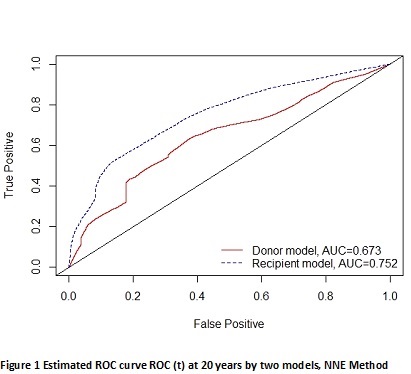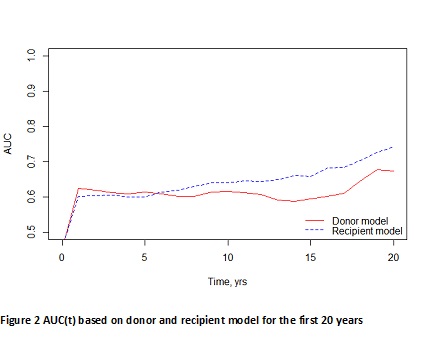
Relative Risk Over Time of Donor and Recipient Factors on Kidney Graft Survival
Jingyan Yang3, Christine L Sardo Molmenti2, Elliot Grodstein1, Horacio Rilo1, Lewis W Teperman1, Ernesto Molmenti1.
1Surgery/Transplant Surgery, Northwell Health, Donald and Barbara Zucker School of Medicine at Hofstra/Northwell, Manhasset, NY, United States; 2Occupational Medicine, Epidemiology and Prevention, Northwell Health, Donald and Barbara Zucker School of Medicine at Hofstra/Northwell, Great Neck, NY, United States; 3Epidemiology, Mailman School of Public Health, Columbia University, New York, NY, United States
Background:The current kidney allocation system (KAS) is based on the Kidney Donor Profile Index (KDPI) and the Estimated Post-Transplant Survival (EPTS), quality-based “longevity matching” strategies that provide only a momentary snapshot of expected outcomes at the time of transplantation.
The purpose of our study was to define on a continuous timeline the relative risk as well as the mutual interactions of both donor and recipient characteristics on graft survival after transplantation.
Methods: 39,108 subjects who underwent kidney transplant between October 25, 1999 and January 1, 2007 were identified in the United Network for Organ Sharing (UNOS) dataset. Donor age, height, weight, ethnicity, history of hypertension, history of diabetes, cause of death, serum creatinine, hepatitis C virus status, and donation after circulatory death, were assessed. Recipient variables included age, gender, BMI, history of previous kidney transplant, previous malignancy, peripheral vascular disease, drug-treated COPD, symptomatic cerebrovascular disease, hepatitis C status, dialysis at transplant, diabetes at registration, and education. Kidney recipients younger than 18, with missing age, and those with multiple transplants were excluded. Our primary outcome was graft survival.
Results: During the first year after transplantation, both donor and recipient models showed identical relevance. From the first to the sixth years, although the two ROC curves were nearly identical, the donor model outweighed the recipient model. Both models intersected again at the sixth year. From that time onward, the ROC curve for recipient characteristics model predominated over the ROC curve for donor characteristics model. The predictive value of the recipient model (AUC=0.752) was greater than that of the donor model (AUC=0.673)


Conclusions: We propose a predictive model that evaluates the dynamic effect and relevance of both donor and recipient characteristics after transplantation. As opposed to the KDPI tables that use logistic regression analysis assuming a fixed time, our model incorporates the concept of evolving risk over time. We also further define the short, intermediate, and long-term interaction of both donor and recipient characteristics on kidney graft survival. Our model expands the number of variables of the EPTS, and could be applied based on characteristics at the time of the organ offer to avoid continuous deterioration of potential recipients. Although we used the same variables than KDPI, our study had a better predictive value than that of the KDPI. We hope that this model will provide additional guidance and risk stratification to further optimize organ allocation based on the dynamic interaction of both donor and recipient characteristics over time.
This work was supported in part by the Health Resources and Services Administration contract 231–00–0015. The content is the responsibility of the authors alone and does not necessarily reflect the views or policies of the Department of Health and Human Services, nor does mention of trade names, commercial products, or organizations imply endorsement by the U.S. Government..
